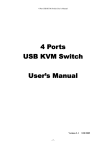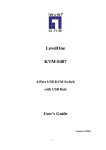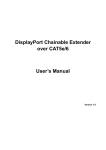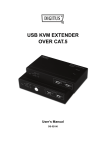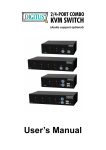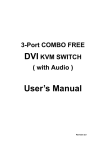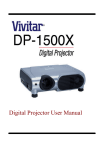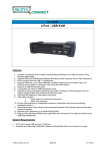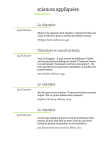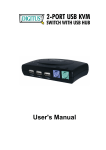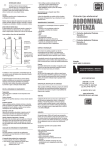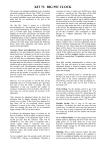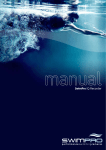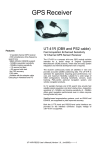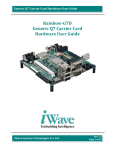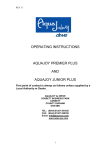Download 4-Port Pocket USB KVM Switch with USB 2.0 Hub Manual
Transcript
4-Port Pocket USB KVM Switch with USB 2.0 Hub Manual -1- Index 1. INTRODUCTION............................................................................................. 3 1.1 FEATURES ...................................................................................................... 3 1.2 PHYSICAL DIAGRAM ......................................................................................... 4 1.3 PACKAGE CONTENTS ....................................................................................... 4 2. SPECIFICATIONS .......................................................................................... 5 2.1 ERAL .............................................................................................................. 5 2.2 LED INDICATORS............................................................................................. 6 3. INSTALL THE USB KVM SWITCH ................................................................. 7 3.1 SYSTEM REQUIREMENTS .................................................................................. 7 3.2 HARDWARE INSTALLATION................................................................................. 7 3.3 Notice for Sun Micro System user.................................................................. 7 3.4 POWERING UP THE SYSTEMS ............................................................................ 7 3.5 DRIVER INSTALLATION ...................................................................................... 7 3.6 USING THE OSD PROGRAM .............................................................................. 10 4. SWITCHING THE USB KVM SWITCH............................................................ 13 *AUTO-SWITCH FUNCTION............................................................................... 15 *AUTO-SCAN FUNCTION................................................................................... 15 *Sun Micro System Key Emulation ...................................................................... 17 -2- 1. Introduction Thank you for purchasing our USB KVM Switch! You now have a high quality and durability system that can give you the control over multiple computers/servers from one console (Mouse, Keyboard and Monitor). 1.1 Features 1. Controls 4 computers from a single console (Keyboard/Mouse) over USB connection using standard USB cables. 2. Supports PS/2 and USB Keyboard/Mouse (Hot-Key function supports only on PS/2 Keyboard). 3. Fully compliant with the USB 2.0 specification. 4. Supports Windows, Linux, Mac OS9/OSX, SunMicro Solaris 8 (For Sun Micro users, the external power adaptor is necessary when using the KVM Switch). 5. Supports 3 USB 2.0 downstream ports. 6. 4 computers can share 3 USB 2.0 Downstream ports. 7. Supports 3 types of switching: hardware push button, Hot-Keys on PS/2 keyboard, and On-Screen-Display (OSD) utility software (for Windows only). 8. OSD and LED display for easy status monitoring. 9. OSD utility indicates: 1. Power status of connected computer(s). 2. Active host computer. 10. Provide HUB switching in independent method or combination with the host switching( AutoSwitch mode ). 11. Auto-Scan function (Time interval can be adjusted between 5-20 seconds when the Auto-Scan function is enable). 12. Supports VGA resolutions up to 2048x1536 @ 85HZ. 13. Plug and Play (Windows 98/SE users might need your Windows CD to install the HID driver for USB Keyboard/Mouse). -3- 1.2 Physical Diagram Host LED HUB Push Button AutoScan Button AutoScan LED C Hub AutoSwitch LED 1.3 Package Contents The product you purchased should contain the equipment and accessories shown as follows: 1. USB KVM Switch. 2. 2 pcs. KVM cable sets, 1,8 m 3. CD with users manual, On-Screen-Display(OSD) utility. -4- 2. Specifications 2.1 General Specification Operating Temperature 5~ 40°C Humidity 0%~80%RH Dimensions (LxWxH) 200 x 82 x 44mm Unit Weight 721g Number Of Computer Controlled 4 PS/2 Keyboard & Mouse Support Yes Keyboard Hot-Key Switching Supported Yes (By PS/2 Keyboard only) USB 2.0 Downstream ports 3 Compliant with USB Version USB 1.0 / USB 1.1 / USB 2.0 Compliant with HID Version USB HID 1.1, 2.0 Over-Current protection design for USB Downstream ports Yes Power By Host or External Adaptor (Optional) Basic Power Consumption DC 5V Bus-Power limit current protection 500mA (When external adaptor applied) Output Voltage 5V Output Current 2A OSD (On Screen Display) Yes (Application Program, Windows only) DDC, DDC2 monitor Yes (Max. Resolution: 2048x1536) Hot Pluggable Yes (USB & PS/2) Auto-Scan function Yes (5 ~20 seconds) Support Sun Micro Serious Yes Support Mac Serous Yes Support Linux Serious Yes Device driver No -5- 2.2 LED Indicators l Power status LED indicator: On (Green): The power is connected and the device is ready to work. Off: No power is connected. l USB 2.0 Downstream Ports LED Indicator: ON (Green): USB ports are ready to work. Off: USB ports are in over-current condition or are not ready to work. Note: If over-current situation happens for certain USB downstream ports, the corresponding USB 2.0 indicator will turn OFF to indicate that these ports is not working now. When over-current situation is solved, the USB indicator will turn ON again. l Auto-Switch LED Indicator: ON: Auto Switch mode is on. Off(Green): Auto Switch mode is off. l Auto-Scan LED Indicator: Off: Auto Scan mode is off. ON (Green): Auto Scan mode is on. l PC Host LED Indicator (Red): ON: Indicates which Host PC is selected. l HUB LED Indicator (Green): ON: Indicates which Host connect with the three USB 2.0 downstream HUB ports. -6- 3. Install USB KVM Switch 3.1 System Requirements A PC with 1 spare USB port and 1 VGA port. Windows 98 or later, Mac OS9/OSX, Solaris 8 (SUN BLADE 100), Linux Kernel 2.3 or later. 3.2 Hardware Installation Make sure that the USB port of your computer is enabled and working properly. Connect the USB cable Type-A end to the USB port of your computer, and the USB cable Type-B end to the any available upstream on USB KVM Switch. Connect the VGA male-to-female cable between the video port of your computer and video port that corresponds to the USB port you selected in step 2. Repeat steps 1-3 for any other computers you are connecting up. Up to 4 computers can be connected at the same time. Plug the power adaptor cable into the USB KVM Switch (optional). 3.3 Notice for Sun Micro System user Since some Sun Micro system will detect the monitor information, if system fail to get information from the Monitor, then you won’ t get any screen came out. So for safety, “YOU MUST SWITCH USB KVM SWITCH TO THE SUN MICRO SYSTEM”before you power on the Sun Micro System. After you seeing the screen from the Sun Micro System, then you can switch to any other Host. If you have multiple Sun Micro systems, then you have to repeat this procedure one by one. 3.4 Powering up USB KVM Switch USB KVM Switch supports USB plug & play technology. All the components can be added and removed at any time without the need to shut the unit down. 3.5 Driver Installation (Windows 98/SE only) After you connect USB KVM Switch to your PC, Win 98 will automatically detect the device and prompt for the driver installation. Please install USB KVM Switch by following the instruction from Step A-E. Please have your Windows 98 CD ready. -7- A. Press “Next”to Continue. (Ref. Fig. A) Fig. A B. Tick “Search for the best driver for your device”and press “Next” to continue. (Ref. Fig. B). Fig. B C. Please insert the “Windows 98”CD into your CD-ROM drive. Tick “CD-Rom drive”and press “Next”to continue. (Ref. Fig. C) Fig. C -8- D. Press “Next”to start the installation process. (Ref. Fig. D) Fig. D D1. Sometimes Windows cannot locate the necessary driver automatically. So you need to choose “Browse” to specify the location of the driver on your “Windows 98”CD manually. * (Ref. Fig. D1) Fig. D1 * The driver might be located in a different directory from the figure above. -9- D2. Press “OK”to continue (Ref. Fig. D2) Fig. D2 E. Press “Finish”and Windows has finished installing the USB Human Interface Device driver for PS/2 keyboard & mouse. (Ref. Fig. E) Fig. E 3.6 Using the OSD program Fig. F - 10 - There are four different statuses: a. “No PCs Found”means that USB KVM Switch cannot acquire the PC status. This is either the PC did not connect or is powered off. (Ref. Fig. G) Fig. G The “Large RED colour 4”and “Small GREEN colour 2”means that 2 PCs are connected to Port 1 and Port 4 of your USB KVM Switch respectively, and you have switched to Port 4 already. So the OSD program displayed a “PC 4 On”underneath. You can click “Small GREEN colour 2”to switch to this available host. (Ref. Fig. H) Fig. H The “Large RED colour 4”and “Small GREEN colour 1, 2, 3”means that four PCs are connected to Port 1 and Port 4 of your USB KVM Switch respectively, and you have switched to Port 4 already. So the OSD program displayed a “PC 4 On”underneath. You can click Small GREEN colour 1, 2 or 3”to switch to a certain available host. (Ref. Fig. I) Fig. I - 11 - 1 2 3 Fig. J 1. When user click “Hide”button, OSD program window will hide in Taskbar. 2. When user click “Close”button, OSD program will exit. 3. If OSD program hide in Taskbar, user can use mouse right button to show or exit program. - 12 - 4. Switching the USB KVM Switch USB KVM Switch supports 3 methods to switch between computers: Push button, Hot Keys and OSD. Due to refresh of the video and re-synchronization of the mouse and keyboard signal, it will take 1-3 seconds configure time after each switching. This is the normal operation that ensures the proper synchronization is established. Note: The drivers for most USB devices (Mass Storage device, CCD Cameras, Scanners, Card Reader, Printers, e.g.) are required to be shut down or follow the “Safely Remove”command provided in Windows before you disconnect the device, or else the system might be hanged. When you switch computers with the Port Selection Switch, it is the equivalent of disconnecting the device. Therefore, if you have peripheral devices (other than a second keyboard and mouse) connected to these ports, you must be sure to shut down or safely remove the USB driver for them before switching computers. 1. Manual Switch by pushbutton: You can switch to any other available active USB host connection by simply push the appropriate switch button on USB KVM Switch. The LED will be lit to indicate which port is currently selected. 2. Two Steps Hot Key Switch by keyboard: You can switch to any available active USB host connection by using the three steps Hot Key directly, instead of manually select by pushbutton. To send commands to USB KVM Switch, must be pressed twice ( Step1 ). Then you can press [1] to [4] (Step 2) to switch between ports. (Support PS/2 Keyboard only) - 13 - *After invoking the Hot Key function with the you must key in the corresponding active key (Step 2) within 3 seconds for each key press. (The Scroll LED will start blinking and wait for the Step 2 hotkey, after pressing any key or over 3 seconds, the keyboard LED will back to the original status.) Three Steps Hot Key definition table Step 1 Step2 Action USB HUB Auto-Switch mode Switches access to the computer which connecting to host1 Switches access to the computer which connecting to host2 Switches access to the computer which connecting to host3 Switches access to the computer which connecting to host4 Switch the HUB to host 1 Switch the HUB to host 2 Switch the HUB to host 3 Switch the HUB to host 4 * No Scroll Key Need * * * AutoScan time interval is 5 seconds (Available only when Auto-Scan function is ON) AutoScan time interval is 10 seconds (Available only when Auto-Scan function is ON) AutoScan time interval is 15 seconds (Available only when Auto-Scan function is ON) AutoScan time interval is 20 seconds (Available only when Auto-Scan function is ON) * Notice : To adjust the interval time for AutoScan, you do not need to press the SCROLL key, and this can be used only by normal number key. - 14 - 3. On-Screen-Display (OSD) Switch (Windows only): You may also use the OSD utility software from the enclosed CD to switch between computers. * Auto-Switch Function: When Auto-Switch mode is ON: When you enable the AutoSwitch mode will cause the USB KVM Switch to switch the HUB with the host together when you switch the host, that means host and HUB will switch together, it could be by hotkey, push button. This is convenient for you to let the USB device always follow the host. There are two ways to turn the HUB Auto-Switch mode ON : A). By hot key [Scroll+Scroll][H] : please be reference the hotkey table in page 14. B). Press any host push button continually for 2 seconds when the Auto-Switch mode is OFF. ( The Auto-Switch LED will be ON ). When Auto-Switch mode is OFF: You must switch the hub to the new target host by hotkey. There are two ways to turn the HUB Auto-Switch mode OFF : A). By hot key [Scroll+Scroll][H] : please reference the hotkey table in page 14. B). Press any host push button continually for 2 seconds when the Auto-Switch mode in ON. ( The AutoSwitch LED will be OFF).. * Auto-Scan Function: When you press the Auto-Scan button, USB KVM Switch switches cycles through all the ports and displays them on the monitor. Each port is displayed for 5,10,15,20 seconds before switching to the next. You can press the normal numeric key 1,2,3,4 to adjust the interval time(Please reference the hotkey table in page 14). If you press the Auto-Scan button again, the monitor screen will jump back to the port that it was started. Note: The mouse and keyboard will have no effect in this mode. This is necessary to prevent errors such as erratic movement and wrong characters to display when using the mouse or keyboard in accident. - 15 - Auto-Scan Interval timer [n] *(Available only when Auto-Scan function is ON) You can change the Auto-Scan interval by pressing the appropriate number key or the number pad keys. [jw1] n [1] [2] [3] [4] [5] [6] [7] [8] [9] [0] Scan Interval 5 sec. 10 sec. 15 sec. 20sec. 25sec. 30sec. 35sec. 40sec. 45sec. 50sec. - 16 - * Sun Micro System Function Key Emulation: There are 16 special functions on the Sun Micro system keyboard, the USB KVM Switch can emulate these function keys via the PS/2 keyboard ( it won’ t work on the USB keyboard ). Here is the mapping table for these function operation. To active these emulation on the PS/2 keyboard, you have to press the LEFT Window KEY first ( this key usually is located between the left [Ctrl] and left [Alt]), then choice the second relative key. Sun Micro System Function Key Stop PS/2 Keyboard Props L_Win & L_Ctrl Compose L_Win & L_Shift Front L_Win & F1 Open L_Win & F2 Find L_Win & F3 Again L_Win & F4 Undo L_Win & F5 Copy L_Win & F6 Paste L_Win & F7 Cut L_Win & F8 Help L_Win & F11 Power L_Win & F12 Mute L_Win & 1 Volume Down L_Win & 2 Volume UP L_Win & 3 L_Win & L_Alt - 17 - FCC Statement This device generates and uses radio frequency and may cause interference to radio and television reception if not installed and used properly. This has been tested and found to comply with the limits of a Class B computing device in accordance with the specifications in Part 15 of the FCC Rules. These specifications are designed to provide reasonable protection against such interference in a residential installation. However, there is no guarantee that interference will not occur in a particular installation. If this device does cause harmful interference to radio or television reception, which can be determined by plugging the device in and out, the user can try to correct the interference by one or more of the following measures: l Reorient or relocate the receiving antenna. l Increase the separation between the device and receiver. l Connect the computer into an outlet on a circuit different from that to which the receiver is connected. l Consult the dealer or an experienced radio/TV technician for help. Safety Information: This device may only be operated in enclosed, dry rooms. To prevent the risk of fire or electrical shock, the device must be protected from moisture. In the event of a defective power plug, please contact an authorized retailer. In the event of damage to the housing or the power plug, do not operate. Do not open the device. Repairs may only be performed by an authorized retailer. Note: In the event of incorrect installation and improper use in a residential area, the device may cause disruptions in radio devices and other electronic devices. Proper use means that the device is operated with shielded connector cables as far as possible, for network products also with shielded cables of category 5e and higher. The device was tested and lies within the limits for computer accessories of class A according to the requirements of EN 55022. Warning: This is a class A device. This device can cause radio interference in residential areas; in this case, the operator may be required to perform and bear the costs for appropriate measures. Conformity Declaration: The device fulfils the EMC requirements of EN 55022 class A for ITE and EN 55024. Devices with external or built-in power supply also fulfil the requirements of EN 61000-3-2 and EN 61000-3-3. The basic protection requirements of the “EMC Directive”89/336/EEC are therefore fulfilled. The CE conformity has been certified. The corresponding declarations are available from the manufacturer. Trademarks: All company, brand and product names used in these instructions are trademarks or registered marks of the corresponding companies. - 18 -


















